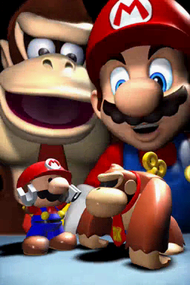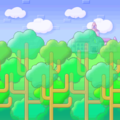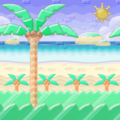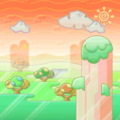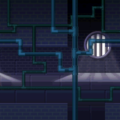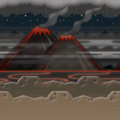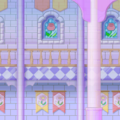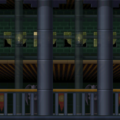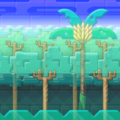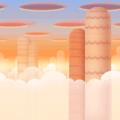Mario vs. Donkey Kong 2: March of the Minis
Template:Infobox Mario vs. Donkey Kong 2: March of the Minis is a puzzle game and the follow-up to Mario vs. Donkey Kong. This time around, the focus is on the Mini toys created by the Mario Toy Company; along with the Mini Mario toys returning, more new toys were added for this game including the Mini Donkey Kong, Mini Toad, and Mini Peach toys. This game also marks the first appearance of Pauline in the Mario series since the Game Boy Donkey Kong game.
Storyline
Mario's Toy Company returns and is mentioned at the beginning of the game. It starts with a commercial promoting the new Super Mini Mario World, which is an outdoor amusement park centered around the Mini Marios, Mini Peachs, Mini Toads, and Mini Donkey Kongs. A crowd of Toads is shown watching Pauline and Mario about to cut the ribbon to open it. One of the Mario Toy Company's employees, Donkey Kong, is in the crowd. He immediately falls in love with Pauline and rushes to her with a Mini Donkey Kong to give to her, but Mario hands out a Mini Mario. She chooses the Mini Mario, so Donkey Kong is heartbroken and breaks down a sales post of Mini Marios, even crushing one with his feet. He then heads toward the elevator, grabbing Pauline on his way and knocking Mario to the floor. As Donkey Kong heads toward the elevator, Mario gets up and tries to get to the elevator, but he is too late to rescue her. Donkey Kong brings Pauline up to the roof of the building. Mario doesn't know what to do until two Mini Marios come to offer help.
In the ending, Mario finds Pauline safe with tons of presents in a room on the roof. Donkey Kong looks sorry for what he's done, when a Mini Mario races across the floor to meet a Mini Donkey Kong. Pauline picks up the Mini Donkey Kong and kisses it, making DK happy. Toads appear and everyone waves, leading into the credits.
Gameplay
Unlike the Game Boy Advance predecessor, Mario plays absolutely no role in this game; he is only seen in the beginning of each floor, and before each boss fight and in the final boss fight and following cut-scene. Instead, the task is to control the Mini Mario toys through eight diverse floors of nine levels each to reach Pauline. At the end of each floor is a boss battle with DK. There are 240 Minis in all - generally, there are more minis in a level as the difficulty increases (going as high as 8 in a level called 8-3). This change in gameplay laid the foundation for the two Mario vs. Donkey Kong games that followed on the DS.
Controls
In each level, the player attempts to move all of the Minis on the map to a portal-like doorway that has a red M on top - this is the goal. Moving the Minis around uses the stylus and touch screen entirely. Touching a Mini activates it. Swiping a Mini left or right moves it in that direction or switches directions. Swiping the same way across multiple Minis changes the direction of all the Minis. Swiping up makes a Mini jump. Swiping down on a Warp Pipe makes the Mini go down into it, and jumping and swiping up makes a Mini go up a pipe. Touching a Mini again stops it.
Minis automatically change directions when hitting a wall or another Mini. Also, a Mini gives a warning "whoa!" noise when it is about to fall into spikes or another danger that will break it, including large heights.
What makes the game challenging is the requirement of having to move environmental pieces of the level around to reach the Goal - similar to Lemmings. For example, colored blocks (most commonly pink) can be realized if the player has a certain number of blocks in the inventory - for example, players can take three blocks from one part of the level and use them somewhere else, perhaps where the Minis need to cross first. Other such examples are elevators with an up and down pad and conveyor belts with a left and right pad.
The player has 300 seconds to move as many of the Minis as possible when the timer starts. The timer does not start until a Mini is activated or colored blocks are removed - the player can look around the level using the D-pad (or buttons for left-handers) and plan what to do before beginning.
Scoring and Stars
Scoring is specific and precise for each level. Small and big coins are spread throughout the levels (50 and 500 points, respectively). Each second left on the clock is another 10 points. There are many bonuses that come into effect:
- Each Mini coming in safely is 1000 points.
- If all Minis come in safely, the bonus is 5000 points.
- Mini-Mario Cards, one per level, are worth 1000 points.
- Getting Minis into the Goal very close to each other is called a chain. Starting at 1000, that bonus is doubled for each additional Mini in the chain; for example, 2 Minis in a row is 1000 + 2000 = 3000 points, and 4 minis in a row is 1000 + 2000 + 4000 + 8000 = 15000 points. The bonus increases exponentially. A blue sparkle surrounds the Goal to signify the chain is still going, and it lasts for about three seconds after the last Mini in the chain.
- If all Minis come in safely in a perfect chain (all Minis coming in within seconds of each other), there is another bonus of 5000 points.
- If a Gold Mini-Mario is at the back of a perfect chain, the last bonus is doubled again (3 Minis = 1000 + 2000 + 8000 = 11000 point bonus)
- Finally, there is the Non-Stop bonus. It is achieved by having a Mini "never stop" from when it is activated to the goal. Stopping at an elevator or on an enemy doesn't count against the player. It is 1000 points per Mini, but having all of the Minis non-stop provides a big extra boost.
By filling in all of the criteria above, the player can earn a gold star for the level. Below it is the silver star and the bronze star. It is possible to get no star, especially if the player loses more than one Mini. Stars are used to unlock extras at the end of the game.
The following is a chart of the bonuses for the number of Minis that appear in the normal game, Gold Mini or not, and the minimum scores for the stars:
| # of Minis | Gold? | G/S/B Minimum Scores | All Non-Stop Bonus |
|---|---|---|---|
| 2 | No | 22200/11450/9450 | 7000 |
| 3 | No | 27200/12700/10700 | 8000 |
| 3 | Yes | 31200/13700/10700 | 8000 |
| 4 | No | 36200/14200/12200 | 9000 |
| 4 | Yes | 44200/16200/13200 | 9000 |
| 5 | No | 43200/18200/13200 | 10000 |
| 6a | Yes | 107200/20450/14450 | 11000 |
| 8b | Yes | 395200/45200/17200 | 13000 |
↑ refers to the entry just above it
aOnly in Level 3-3
bOnly in Level 8-3
Floors
Each floor of Super Mini-Mario World besides the Basement is diverse and has its own unique elements that sets it apart. They each consist of nine levels, a mini-game, and a DK boss battle.
Mini-Game
In each level of a floor, there is a Mini-Mario Card - a card with a letter on one side and a Mini-Mario's head on another. With nine levels, the cards spell MINIMARIO on each floor (i.e. 7-3 would have a N card). Finding all cards in a floor unlocks a single Mini-Game: Shy Guy Smash. In it, the player uses the stylus to break (touch) 25 Mini Shy Guys within 30 seconds, coming out of pipes. Unfortunately, not only do the pipes become more complicated as the floors increase, Mini Bob-ombs are thrown into the mix - tapping them loses 5 points. The player is challenged to beat his or her high score after getting over 25, for replay value.
DK Boss Battle
Each floor is concluded by a boss battle with the giant ape. Players must launch Mini-Marios from a cannon up and hit Donkey Kong either directly or indirectly, depending on conditions. The number of Minis available depends on how many Minis the player got to the Goal in the nine levels. In odd-numbered floors, the cannon will shoot directly up, trying to hit DK from below. In even-numbered levels, DK is protected by a spiked platform from the bottom, and the cannon is adapted to hit off of walls to reach above him instead, as illustrated to the right. Minis are broken by sharp points, DK's projectiles such as bananas, barrels, mines, even fireballs, or in the later battles, Swoopers (Spooky Attic) and Vine Crocodiles (Jungle Hijinks). DK has six hit points in all battles.
Each of these boss battles is also capable of getting stars, but the score is calculated differently. Simply put, the gold star minimum is the maximum number of Minis on the floor times 1,000 (25,000, 30,000, etc). Each second left on the clock is ten points (each boss battle starts with 180), and each Mini still "alive" is still 1000 points. Getting a gold star thus should mean that no Minis can be destroyed and perfect play is required. However, in theory, it is possible to win with over 100 seconds of time remaining - which is 1,000 or more points left over - which means that a player can still miss one Mini and earn a gold star. However, it gets more difficult to beat DK within those eighty seconds as the game progresses, so it should not be taken as a rule of thumb. Silver stars are generally 75% of the Minis surviving, and bronze stars 50%.
Final Boss Battle
Immediately after the Minis defeat Donkey Kong at Jungle Hijinks, the final boss battle begins. Here, the level 25m from the original Donkey Kong game is used. Mario waits at the top screen, while DK throws barrels down into the lower screen. Minis will actually come from the Goal, and it is the player's job to get six Minis into the upper screen for Mario to throw at DK before six Minis are destroyed by barrels or fire from the tar pit (also from Donkey Kong). Ladders accompany this section, as well as the Hammer power-up on two occasions. This battle is not ranked and the ending and credits follow success.
Modes
- Main Game - described above. There are three save files.
- Construction Zone - A Level Editor feature is also present in this game, where players can create their own levels. Friends can also utilize a Wi-Fi connection to share levels online.
- Play Level - Levels created by the player or received from others, that have passed a play test (all Minis can reach the goal), can be played here.
- Edit Level - Players can create or edit a preexisting level here, from one of eleven kits. See how kits are unlocked is described below.
- Erase Level - Players can delete levels at will.
- Nintendo WFC - These options allow interactions with other players.
- Synchronize - Players must connect to the WFC to get their own levels ready to send to others.
- Receive - As long as each player know each other's friend codes and have them installed under their friends list, levels can be received from either at will. Nintendo also has been publishing a level every so often.
- Nintendo WFC Config - Players can get WFC setting ready here, like in any Wi-Fi game.
- WFC Friends - Up to sixty friends can be stored here, registered with a friend code. The player's friend code is on the top screen.
- Multi-Card - Two friends, each with a copy of the game and close to each, can send and receive files locally.
- Broadcast - Same as sending. The other player must choose "Receive" for this to work.
- Receive - The other player must choose "Broadcast" and choose a level for this to work.
- Options - March of the Minis has some unique features and bonuses.
- Audio - adjusts settings from Stereo, Surround, or Headphones. The player can hear every sound effect and music track in the game when they beat the Main Game. There are one hundred forty four sound effects and seventy seven music tracks in all.
- Showroom
- Movies - Players can watch the four real-time movies again and again here. Only one - pre-title - is unlocked at the beginning, so again the Main Game must be played to find them all. The additional movies are Introduction, Ending, and Musical.
- Gallery - Players can look at eighteen pictures from the Main Game here. sixteen are two from each floor, before and after the boss battle. The next is before the final battle on the Roof, and the last is from beating the first level in the basement.
- Credits - Replays the credits. The player must finish the Main Game at least once to unlock it.
- Title - On the title screen, Mini-Marios walk across the bottom of the top screen. This cosmetic feature can be changed, but it requires stars to do so.
- Register - Players can register their name as it appears in the Construction Zone and Wi-Fi Connection here.
- Single Card - A demo version of the game can be sent to another DS player without the game card.
- Erase All - Not only does this delete all Main Game data, but all Construction Zone levels, created or received, and it resets the player's friend code.
- NintendoWiFi.com - Players can choose to let their statistics be part of Nintendo's official Wi-Fi site.
Game Elements
Minis
| The Mini | Normal form | Fire form |
|---|---|---|
| Mini Mario | ||
| Mini Toad | ||
| Mini Peach | ||
| Mini Donkey Kong | ||
| Gold Mini Mario | N/A |
Items and Objects
This article is under construction. Therefore, please excuse its informal appearance while it is being worked on. We hope to have it completed as soon as possible.
| Item | About |
|---|---|
| Coins are used to raise the score, collecting 100 gets the player a M-Token. | |
| File:Large Coin.PNG10 Gold Coin | 10 Gold Coins are used to increase the score, but are worth 10 normal coins. |
| Cards are collectible items with a picture of Mini Mario and a letter on the back of them. There are 9 cards per world. | |
| Doors are the goal of the levels. If all the Mini Marios make it to the door the level is won. | |
| Hammers are found floating in some levels. Hammers allow the Mini Marios to defeat enemies. | |
| ? Blocks contain Fire Flowers. | |
| An item that comes out of a ? Block, it turns Mini Mario into Fire Mini Mario, which allows him to hurl fireballs within a limited time to stun or defeat enemies. | |
| Pink Blocks are objects that are used as bridges between the corresponding bracket. Pink Blocks can be collected and placed within a level. | |
| Yellow Springs are used to fling Mini Marios to higher places. | |
| Blue Springs are used to fling Mini Marios to higher places, but also flings them forwards at the same time. | |
| Conveyors are objects that move in one direction, but can be reversed using a button. Mini Marios can't go the opposite direction because the conveyor belt moves faster than the Mini. | |
| Elevators are platforms that move up and down. Once the direction of the elevator is selected it can't be changed until the elevator reaches a floor. An elevator can hold up to two Mini Marios. | |
| Color Switches let the player open gates with the same color, while closing gates that have different colors. There are 3 colors of Color Switches. | |
| Warp pipes send Mini Marios that enter it to a different part of the level. | |
 Rotate Pipe Rotate Pipe
|
Rotate Pipes are warp pipe sections that when tapped rotate 90° to allow the player to reach different warp pipe exits in the level. |
 Water Valve Water Valve
|
|
| Magnetic Blocks allow Mini Marios to walk on any direction, even upside-down. They can be collected and placed within a level. | |
| Swing Bar | Swing Bars are objects that can be used to cross gaps. They can also be used to launch Mini Marios upward. |
| A block that falls after being walked on by Mini Marios. | |
| Moving Platform | |
| Balance Beam | |
| Fire Blocks are blocks that can burn wood. | |
| Bomb Blocks are blocks that can destroy breakable blocks. |
Enemies
The following is a list of enemies in the game:
- Bloopers
- Bomb Fish
- Candles
- Fires
- Fire Bars
- Fire Piranha Plants
- Jetpack Guys
- Kongās
- Mini Bob-ombs
- Mini Crabs
- Mini Shy Guys
- Mini Snifits
- Mummy Guys
- Nitpickers
- Polterguys
- Snapjaws
- Sparks
- Swoopers
- Thwomps
- Capture Kongs
- Circus Kongs
- Cool Kongs
- Crash Kongs
- Donkey Kong
Unlockables
March of the Minis boasts a supply of unlockables, some minor and some major:
- Construction Kits. In the Construction Zone, players choose a kit, one from each floor that incorporates the elements and enemies of that floor. Players unlock each kit as they beat the DK boss battle for each floor.
- Bonus Construction Kits. By completing the mini-game in each floor (and ultimately collecting all of the Mini-Mario Cards), special kits are unlocked (Kit 1 is Floors 1-3, Kit 2 is Floors 4-6, and Kit 3 is Floors 7-8). Not only are the elements combined from the floors (with some bonuses, with Special Kit 3 containing every element in the game - and more), but players no longer control Mini Marios. Mini Toads, Mini Peaches, and Mini Donkey Kongs now become playable, respectively.
- Title Screen Change. To change the Mini Marios on the title screen into Mini Toads, Peaches, or Donkey Kongs, the player needs to have eighty bronze, silver, or gold stars, respectively. Then he or she can change it in the Options → Showroom. They all must be a certain star to be unlocked - seventy nine gold and one bronze still only unlocks the Mini Toads.
- Basement. After defeating the main game, returning to the same save file directs the player to the basement of the theme park, sub-titled "DK's Hideout". Two bonus boss battles similar to the final battle await in Levels B1 and B2. To access them, though, the player needs forty silver and forty gold stars, respectively. B1 requires the player to run over twelve platforms that disappear on contact, six on the upper screen and six on the lower. B2 requires the player to get Minis to the upper screen so they can push a barrel onto Donkey Kong. B1 unlocks the final gallery image; B2 unlocks the final movie. These battles are also not ranked.
Staff
Pre-release and unused content
Gallery
- For a complete gallery of images, see Gallery:Mario vs. Donkey Kong 2: March of the Minis
Course backgrounds
Music
Most of the music are cover versions from other games. The only original compositions in the game are the Pipe Works theme and the main menu theme.
- Mushroom Mayhem: cover of #-MM levels from Mario vs. Donkey Kong.
- Tropical Island: cover of Donkey Kong Jungle theme in Mario vs. Donkey Kong.
- Magnet Mania: cover of underground Levels from most of the Mario games.
- Lava Dome: cover of Bowser's Castle in Super Mario Bros.
- Toadstool Castle: cover of Princess Peach's Castle in Super Mario 64.
- Spooky Attic: cover of Spooky House in Mario vs. Donkey Kong.
- Jungle Hijinks: cover of "Simian Segue (Jungle Theme)" from Donkey Kong Country.
- Boss Battles: cover of first boss theme from Mario vs. Donkey Kong.
- Final Boss: fusion between the 25m theme from the original Donkey Kong and "Simian Segue (Jungle Theme)" from Donkey Kong Country.
- Minigame: cover of the bonus game theme from Mario vs. Donkey Kong.
- If Mini-Marios appear on the title screen, a trumpet cover of the original Super Mario Bros. theme plays
- If Mini-Toads, Peaches, or DKs appear on the title screen, the title music from the original Mario vs. Donkey Kong plays.
References to Other Games
- Donkey Kong: Pauline makes a return to the Mario series. Certain levels are based off of ones found in this game.
- Super Mario Bros.: World 5 uses the castle music from this game. Also the main theme is remixed several times.
- Donkey Kong Country: Music from this game is featured in the jungle levels.
- Mario & Wario: Very similar gameplay to this game.
- Super Mario 64: Music from this game is featured in the castle levels.
- Mario vs. Donkey Kong: A prequel to this game. The Mini-Marios are back and several music is reused from this game. The concept of guiding the Mini-Marios debuted here
- Donkey Kong 64: Several of Donkey Kongs voice clips are recycled.
- Mario Power Tennis: Several of Donkey Kongs voice clips are recycled.
- Donkey Kong Jungle Beat: Several of Donkey Kongs voice clips are recycled.
Trivia
- The game's title name is an allusion to the Beatles song "March of the Meanies".
- In the Level Editor, it is possible to have only one Mini - it's an all or nothing deal (Mini in = 1000 + all in + perfect chain + all non-stop (6000) = 17000 points OR Mini out = failed level, 0 points). The G/S/B is 18200/13200/7200, but unless the player has under 120 seconds left and there are few coins, they are almost forced to get a gold or no star.
- Players can create only eight levels in the Construction Zone, yet receive up to twenty-four levels.
- The credits show 3D pictures of some of the Mini poses and enemies, likely as a throwback to the similar credits pictures in the first Mario vs. Donkey Kong.
- When players close and open their DS (putting it in and out of sleep mode), Mario has some things to say, such as "Hey, come back here, you big-a monkey!", "Let's play again!", and "I love this game!" This feature was also used on the sequels, Minis March Again and Mini-Land Mayhem.
- The gameplay of this game is similar to that of Mario & Wario.
- Although the Mini Peach toys appear in this game, Princess Peach herself makes no appearance.
Template:BoxTop Template:MVDK:MOTM Template:DKGames
